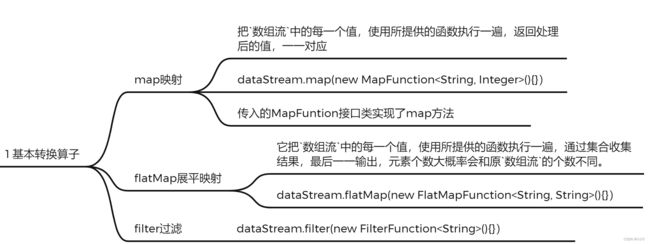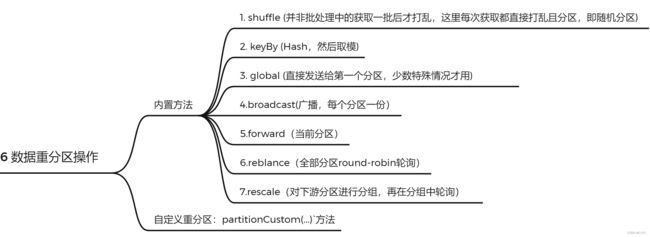【Flink入门(3)】Flink的流处理API
【时间】2022.04.29 周五
【题目】【Flink入门(3)】Flink的流处理API
本专栏是尚硅谷Flink课程的笔记与思维导图。
目录
引言
一、Environment环境
二、Source数据源
自定义Source例子
三、Transform转换
1)基本转换算子
map vs flatMap
例子
2)聚合算子
3)多流转换算子
spilt与select
connet与CoMap
Union
四、支持的数据类型
五、实现UDF函数——更细粒度的控制流
六、 数据重分区操作
七、Sink输出
总的导图
引言
flink流处理API主要分为4部分:Environment环境、Source数据源、Transform转换、Sink输出。
一、Environment环境
二、Source数据源
自定义Source例子
package com.atguigu.apitest.source;
import com.atguigu.apitest.beans.SensorReading;
import org.apache.flink.streaming.api.datastream.DataStream;
import org.apache.flink.streaming.api.environment.StreamExecutionEnvironment;
import org.apache.flink.streaming.api.functions.source.SourceFunction;
import java.util.HashMap;
import java.util.Random;
public class SourceTest4_UDF {
public static void main(String[] args) throws Exception{
StreamExecutionEnvironment env = StreamExecutionEnvironment.getExecutionEnvironment();
env.setParallelism(1);
// 从文件读取数据
DataStream dataStream = env.addSource( new MySensorSource() );
// 打印输出
dataStream.print();
env.execute();
}
// 实现自定义的SourceFunction
public static class MySensorSource implements SourceFunction{
// 定义一个标识位,用来控制数据的产生
private boolean running = true;
// 定义一个随机数发生器
Random random = new Random();
//传感器数据map
private HashMap sensorTempMap = new HashMap<>();
{
// 设置10个传感器的初始温度
for(int i = 0; i <10; i++ ){
sensorTempMap.put("sensor_" + (i+1), 60 + random.nextGaussian() * 20);
}
}
@Override
public void run(SourceContext ctx) throws Exception {
while (running){
for( String sensorId: sensorTempMap.keySet() ){
// 在当前温度基础上随机波动
Double newtemp = sensorTempMap.get(sensorId) + random.nextGaussian();
sensorTempMap.put(sensorId, newtemp);
ctx.collect(new SensorReading(sensorId, System.currentTimeMillis(), newtemp));
}
// 控制输出频率
Thread.sleep(10000L);
}
}
@Override
public void cancel() {
running = false;
}
}}
三、Transform转换
1)基本转换算子
map vs flatMap
例子
package com.atguigu.apitest.transform;
import org.apache.flink.api.common.functions.FilterFunction;
import org.apache.flink.api.common.functions.FlatMapFunction;
import org.apache.flink.api.common.functions.MapFunction;
import org.apache.flink.streaming.api.datastream.DataStream;
import org.apache.flink.streaming.api.environment.StreamExecutionEnvironment;
import org.apache.flink.util.Collector;
public class TransformTest1_Base {
public static void main(String[] args) throws Exception{
StreamExecutionEnvironment env = StreamExecutionEnvironment.getExecutionEnvironment();
env.setParallelism(1);
// 从文件读取数据
DataStream inputStream = env.readTextFile("src\\main\\resources\\sensor.txt");
// 1. map,把String转换成长度输出
DataStream mapStream = inputStream.map(new MapFunction() {
@Override
public Integer map(String value) throws Exception {
return value.length();
}
});
// 2. flatmap,按逗号分字段
DataStream flatMapStream = inputStream.flatMap(new FlatMapFunction() {
@Override
public void flatMap(String value, Collector out) throws Exception {
String[] fields = value.split(",");
for( String field: fields )
out.collect(field);
}
});
// 3. filter, 筛选sensor_1开头的id对应的数据
DataStream filterStream = inputStream.filter(new FilterFunction() {
@Override
public boolean filter(String value) throws Exception {
return value.startsWith("sensor_1");
}
});
// 打印输出
mapStream.print("map");
flatMapStream.print("flatMap");
filterStream.print("filter");
env.execute();
}
}
2)聚合算子
- keyBy的几种写法
// 分组
KeyedStream keyedStream = dataStream.keyBy("id"); //新版本已丢弃
KeyedStream keyedStream1 = dataStream.keyBy(SensorReading::getId);//直接调用类方法的写法
KeyedStream keyedStream1 = dataStream.keyBy(
new KeySelector() {
@Override
public String getKey(SensorReading sensorReading) throws Exception {
return sensorReading.getId();
}
});//传入KeySelctor接口实行类
KeyedStream keyedStream1 = dataStream.keyBy(data -> data.getId());//lambda表达式
- reduce例子
// reduce聚合,取最大的温度值,以及当前最新的时间戳
SingleOutputStreamOperator resultStream = keyedStream.reduce(new ReduceFunction() {
@Override
public SensorReading reduce(SensorReading value1, SensorReading value2) throws Exception {
return new SensorReading(value1.getId(), value2.getTimestamp(), Math.max(value1.getTemperature(), value2.getTemperature()));
}
});
// SingleOutputStreamOperator resultStream =
// keyedStream.reduce( (curState, newData) -> {
// return new SensorReading(curState.getId(), newData.getTimestamp(), Math.max(curState.getTemperature(), newData.getTemperature()));
// });//lambda表达式写法 3)多流转换算子
spilt与select
- 新版flink已经移除了split算子,新版可以通过process + OutputTag侧输出流实现逻辑分流。
// 1. 分流,按照温度值30度为界分为两条流
OutputTag highStream = new OutputTag("high"){};
OutputTag lowStream = new OutputTag("low"){};
SingleOutputStreamOperator low> SensorReading{id='sensor_1', timestamp=1547718199, temperature=35.8}
high> SensorReading{id='sensor_6', timestamp=1547718201, temperature=15.4}
high> SensorReading{id='sensor_7', timestamp=1547718202, temperature=6.7}
low> SensorReading{id='sensor_10', timestamp=1547718205, temperature=38.1}
low> SensorReading{id='sensor_1', timestamp=1547718207, temperature=36.3}
low> SensorReading{id='sensor_1', timestamp=1547718209, temperature=32.8}
low> SensorReading{id='sensor_1', timestamp=1547718212, temperature=37.1}connet与CoMap
- 例子:
// 2. 合流 connect,将高温流转换成二元组类型,与低温流连接合并之后,输出状态信息
DataStream> warningStream = highTempStream.map(new MapFunction>() {
@Override
public Tuple2 map(SensorReading value) throws Exception {
return new Tuple2<>(value.getId(), value.getTemperature());
}
});
ConnectedStreams, SensorReading> connectedStreams = warningStream.connect(lowTempStream);
DataStream resultStream = connectedStreams.map(new CoMapFunction, SensorReading, Object>() {
@Override
public Object map1(Tuple2 value) throws Exception {
return new Tuple3<>(value.f0, value.f1, "high temp warning");
}
@Override
public Object map2(SensorReading value) throws Exception {
return new Tuple2<>(value.getId(), "normal");
}
});
resultStream.print("connect"); connect> (sensor_6,15.4,high temp warning)
connect> (sensor_1,normal)
connect> (sensor_7,6.7,high temp warning)
connect> (sensor_10,normal)
connect> (sensor_1,normal)
connect> (sensor_1,normal)
connect> (sensor_1,normal)Union
四、支持的数据类型
五、实现UDF函数——更细粒度的控制流
六、 数据重分区操作
七、Sink输出
总的导图















